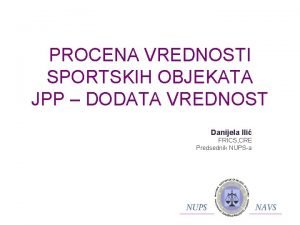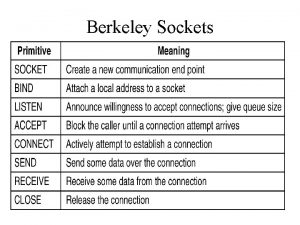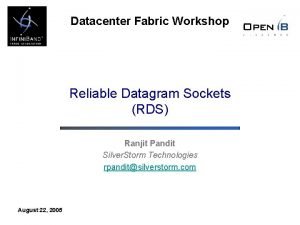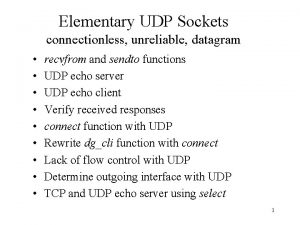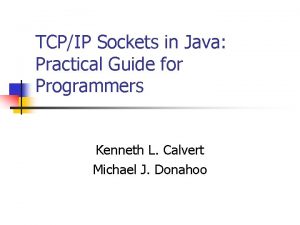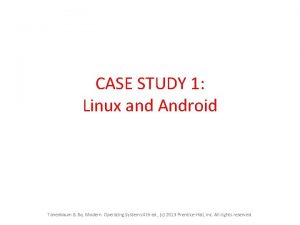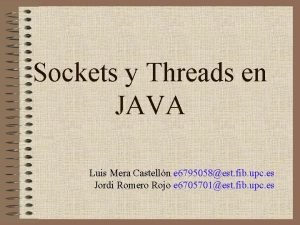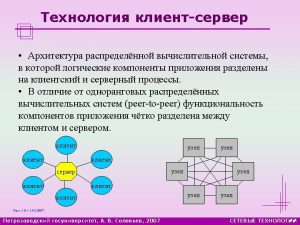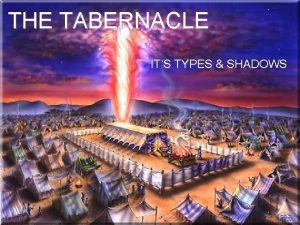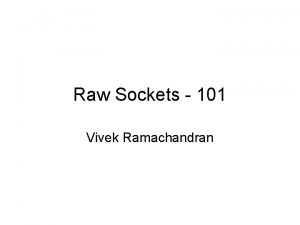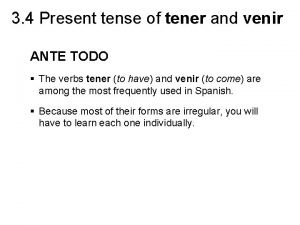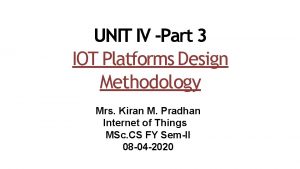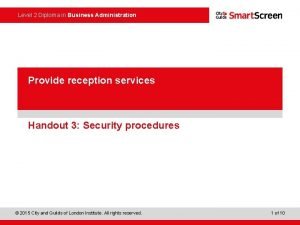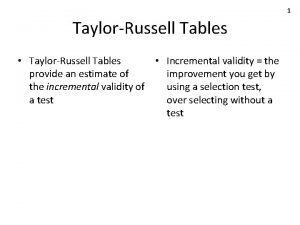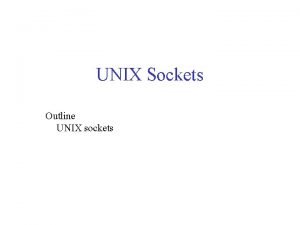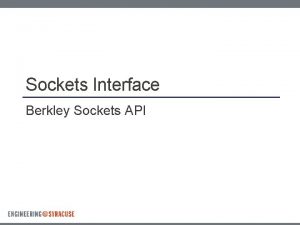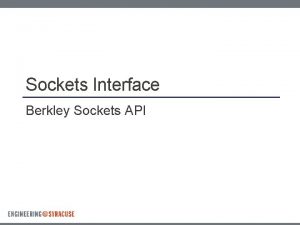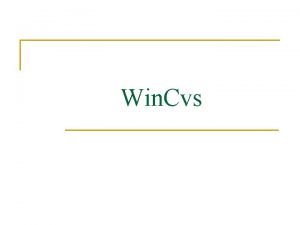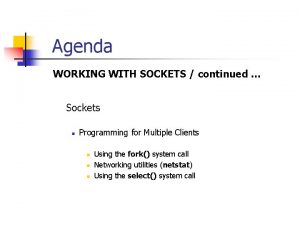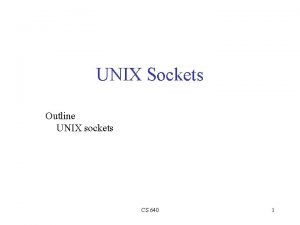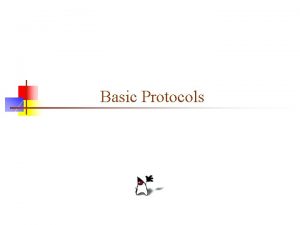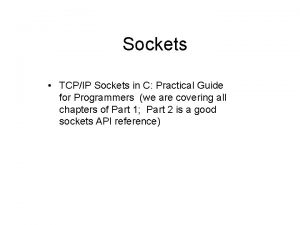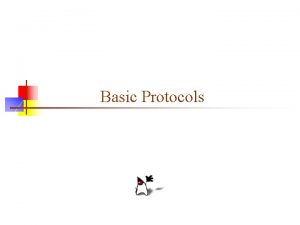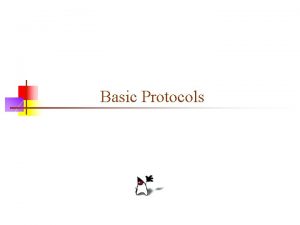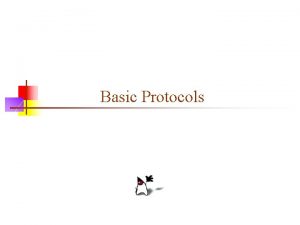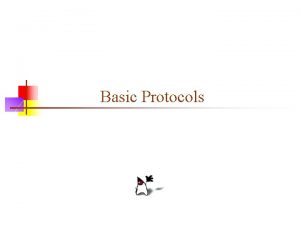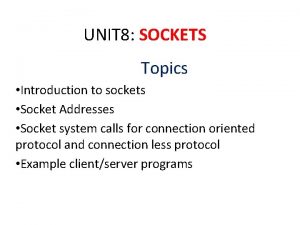Win 32 Sockets What Are Sockets Sockets provide














































- Slides: 46

Win 32 Sockets

What Are Sockets? • Sockets provide a common interface to the various protocols supported by networks. • They allow you to establish connections between machines to send and receive data. • Sockets support the simultaneous connection of multiple clients to a single server machine.

TCP Protocol • TCP/IP stands for Transmission Control Protocol/ Internet Protocol. TCP/IP is the most important of several protocols used on the Internet. Some others are: Hyper. Text Transport Protocol (HTTP), File Transfer Protocol (FTP), Simple Mail Transfer Protocol (SMTP), and Telnet, a protocol for logging into a remote computer. Sockets provide a standard interface for a variety of network protocols. TCP/IP is, by far, the most commonly used protocol for sockets. Here are the main features of TCP/IP: • IP is a routable protocol. That means that TCP/IP messages can be passed between networks in a wide area network (WAN) cluster.

TCP Protocol (cont. ) • Each device using TCP/IP must have an IP address. This address is a 32 -bit word, organized into four 8 -bit fields, called octets. Part of the IP address identifies the network, and the rest identifies a specific host on the network. • IP addresses are organized into three classes. Each class has a different allocation of octets to these two identifiers. This allows the Internet to define many networks, each containing up to 256 devices (mostly computers), and a few networks, each containing many more devices. • A single machine can run multiple communications sessions using TCP/IP. That is, you can run a web browser while using Telnet and FTP simultaneously.

TCP/IP-Based Sockets • Connection-oriented means that two communicating machines must first connect. • All data sent will be received in the same order as sent. • Note that IP packets may arrive in a different order than that sent. • This occurs because all packets in a communication do not necessarily travel the same route between sender and receiver. • Streams mean that, as far as sockets are concerned, the only recognized structure is bytes of data.

Socket Logical Structure

Socket send Behavior • Sockets API provides functions: • int send(SOCKET s, char *buff, int len, int flags) Request to send up to len bytes from buffer buff • int recv(SOCKET s, char *buff, int len, int flags) Request to receive up to len bytes, stored in buffer buff • If receive buffer has space for len bytes, then len bytes are sent and send call returns with value len.

Socket send Behavior (cont. ) • If receive buffer has free space, but less than len bytes, then the receive buffer is filled and send returns the number of bytes actually sent. • If receive buffer is full, send will block until space becomes available.

Socket recv Behavior • Sockets API provides functions: • int send(SOCKET s, char *buff, int len, int flags) Request to send up to len bytes from buffer buff • int recv(SOCKET s, char *buff, int len, int flags) Request to receive up to len bytes, stored in buffer buff • If receive buffer has at least len bytes of content, then len bytes are copied to buff and call returns with value len.

Socket recv Behavior (cont. ) • If receive buffer has content, but less than len bytes, then the receive buffer contents are moved to buff and recv returns the number of bytes actually copied. • If receive buffer is empty, recv will block until content becomes available.

Sockets Interface Berkley Sockets API

Creating Sockets • Socket connections are based on: • Domains—network connection or IPC pipe • AF_INET for IPv 4 protocol • AF_INET 6 for IPv 6 protocol • Type—stream, datagram, raw IP packets, … • SOCK_STREAM TCP packets • SOCK_DGRAM UDP packets

Creating Sockets (cont. ) • Protocol—TCP, UDP, … • 0 default, e. g. , TCP for SOCK_STREAM • Example: HANDLE sock = socket(AF_INET, SOCK_STREAM, 0); • Note: we will focus on the IP 4 interface, since it is simpler than IP 6. Our Socket Library handles both.

Connecting Sockets • Socket addresses struct SOCKADDR_IN { sin_family sin_address. s_addr sin_port } addr; // AF_INET // inet_addr(“ 127. 0. 0. 1”); // htons(8000); • Bind server listener to port: int err = bind(sock, (SOCKADDR_IN*)&addr, sizeof(addr)); • Connect client to server: HANDLE connect(sock, (SOCKADDR_IN*)&addr, sizeof(addr))

Client/Server Processing

Accessing Sockets Library • #include <winsock 2. h> • Link with wsock 32. lib • To build a server for multiple clients you will need to use threads; e. g. : #include <process. h> or #include<threads> // Win 32 threads // C++11 threads and use the Project Settings: C/C++ languagecategory=code generationdebug multithreaded

Project Settings

Sockets API • WSAStartup — loads WS 2_32. dll • WSACleanup — unloads dll • socket • connect • bind • listen • accept • send • recv • shutdown • closesocket — create socket object — connect client to server — bind server socket to address/port — request server to listen for connection requests — server accepts a client connection — send data to remote socket — collect data from remote socket — close connection — closes socket handle

Sequence of Server Calls • WSAStartup • socket (create listener socket) • bind • listen • accept • create new socket so listener can continue listening • create new thread for socket • send and recv • closesocket (on new socket) • terminate thread • shutdown • closesocket (on listener socket) • WSACleanup

WSAStartup w. Version. Requested = MAKEWORD(1, 1); WSAData w. Data; lp. WSAData = &w. Data int WSAStartup( WORD w. Version. Requested, LPWSADATA lp. WSAData ) • Loads WS 2_32. dll

TCP/IP Socket af = AF_INET type = SOCK_STREAM protocol = IPPROTO_IP SOCKET socket(int af, int type, int protocol) • Creates a socket object and returns handle to socket.

Bind Socket struct sockaddr_in local; … define fields of local … name = (sockaddr*)&local namelen = sizeof(local) int bind( SOCKET s, const struct sockaddr *name, int namelen ) • Bind listener socket to network card and port

Listen for Incoming Requests int listen(SOCKET s, int backlog) • Backlog is the number of incoming connections queued (pending) for acceptance. • Puts socket in listening mode, waiting for requests for service from remote clients.

Accept Incoming Connection SOCKET accept( SOCKET s, struct sockaddr *addr, int *addr. Len ) • Blocking call, accepts a pending request for service and returns a socket bound to a new port for communication with new client. • Usually server will spawn a new thread to manage the socket returned by accept, often using a thread pool.

Client/Server Configuration

recv int recv( SOCKET s, char *buff, int len, int flags ) • Receive data in buff up to len bytes. • Returns actual number of bytes read. • Flags variable should normally be zero.

send int send( SOCKET s, char *buff, int len, int flags ) • Send data in buff up to len bytes. • Returns actual number of bytes sent. • Flags variable should normally be zero.

shutdown int shutdown(SOCKET s, int how) • how = SD_SEND or SD_RECEIVE or SD_BOTH • Disables new sends, receives, or both, respectively. Sends a FIN to server, causing thread for this client to terminate (server will continue to listen for new clients).

closesocket int closesocket(SOCKET s) • Closes socket handle s, returning heap allocation for that data structure back to system.

WSACleanup int WSACleanup( ) • Unloads W 2_32. dll if no other users. Must call this once for each call to WSAStartup.

Sequence of Client Calls • WSAStartup • socket • address resolution—set address and port of intended receiver • connect • shutdown • closesocket • WSACleanup —send and recv

TCP Addresses—IP 4 struct sockaddr_in{ short unsigned short struct in_addr char } SOCKADDR_IN; sin_family; sin_port; sin_addr; sin_zero[8];

TCP/IP Address Fields—IP 4 • sin_family AF_INET • sin_port at or above 1024 • sin_addr inet_addr(“ 127. 0. 0. 1”); • sin_zero padding • Setting sin_addr. s_addr = INADDR_ANY allows a server application to listen for client activity on every network interface on a host computer.

connect int connect( SOCKET s, const struct sockaddr *name, int namelen ) • Connects client socket to a specific machine and port.

Special Functions • htons—converts short from host to network byte order • htonl—converts long from host to network byte order • ntohs—converts short from network to host byte order • ntohl—converts long from network to host byte order

Socket Systems Discuss how sockets are used in software systems

Client/Server Configuration

A Word of Caution • With stream-oriented sockets, send does not guarantee transfer of all bytes requested in a single call. • That’s why send returns an int, the number of bytes actually sent. • It’s up to you to ensure that all the bytes are actually sent. • See my code example—socks. cpp


Talk Protocol • The hardest part of a client/server socket communication design is to control the active participant. • If single-threaded client and server both talk at the same time, their socket buffers will fill up and they both will block; e. g. , deadlock. • If they both listen at the same time, again, there is deadlock. • Often the best approach is to use separate send and receive threads.


Message Length • Another vexing issue is that the receiver may not know how long a sent message is. • So the receiver doesn’t know how many bytes to pull from the stream to compose a message. • Often, the communication design will arrange to use message delimiters, fixed-length messages, or message headers that carry the message length as a parameter. • For examples, see: • Repository/Cpp. String. Socket. Server • Repository/Comm. With. File. Xfer // uses string delimiter // uses messages with headers

Message Framing • Sockets only understand arrays of bytes. • Don’t know about strings, messages, or objects • In order to send messages, you simply build the message string, probably with XML. • String msg = “<msg>message text goes here</msg>” • Then send(sock, msg, strlen(msg), flags) • Receiving messages requires more work. • Read socket one byte at a time and append to message string: • recv(sock, &ch, 1, flags); msg. append(ch); • Search string msg from the back for </ • Then collect the msg> • You will find a more sophisticated approach in the Comm. With. File. Xfer, cited on the previous slide.

They’re Everywhere • Virtually every network and Internet communication method uses sockets, often in a way that is invisible to an application designer. • Browser/server • ftp • SOAP • Network applications

What We Didn’t Talk About • udp protocol • socket select(…) function • non-blocking sockets

End
 Think win win scenarios
Think win win scenarios Win win win lose lose lose
Win win win lose lose lose Win-win win-lose lose-lose
Win-win win-lose lose-lose Mikael ferm
Mikael ferm Habit 4: think win-win examples
Habit 4: think win-win examples Win win nacin placanja
Win win nacin placanja Win-win negotiations are also known as
Win-win negotiations are also known as Conflict resolution win win
Conflict resolution win win Habit 4 think win win summary
Habit 4 think win win summary Habit 4 examples
Habit 4 examples Boulwarism negotiation
Boulwarism negotiation Win win examples
Win win examples Habit 4 summary
Habit 4 summary Tcp ip sockets in c
Tcp ip sockets in c Socket r
Socket r Berkely socket
Berkely socket Datacenter fabric
Datacenter fabric D3azeg_clwi -site:youtube.com
D3azeg_clwi -site:youtube.com Tcp/ip sockets in java: practical guide for programmers
Tcp/ip sockets in java: practical guide for programmers Tanenbaum linux
Tanenbaum linux Reliable datagram sockets
Reliable datagram sockets Sockets and threads
Sockets and threads What is the function of the steering system
What is the function of the steering system Secure sockets
Secure sockets Berkeley sockets
Berkeley sockets Raw socket in networking
Raw socket in networking Sockets of the tabernacle
Sockets of the tabernacle Cleanroom 380v sockets
Cleanroom 380v sockets Sockets direct protocol
Sockets direct protocol 도나도나 tcp
도나도나 tcp Raw socket
Raw socket Intentalo provide the appropriate forms of tener and venir
Intentalo provide the appropriate forms of tener and venir Iot design methodolgy is to define the
Iot design methodolgy is to define the People in media and people as media similarities
People in media and people as media similarities What advantages did the tiber river provide
What advantages did the tiber river provide Context clues provide apex
Context clues provide apex If a laboratory fire erupts, immediately
If a laboratory fire erupts, immediately Latent time
Latent time Fca welding
Fca welding Provide reception services
Provide reception services How might a valet satisfy a valet-serviced guest
How might a valet satisfy a valet-serviced guest Used to manually stir solutions
Used to manually stir solutions Used to move beakers containing hot liquids
Used to move beakers containing hot liquids Taylor russel table
Taylor russel table A dermatologist and an oncologist both provide
A dermatologist and an oncologist both provide Retained earnings for sole proprietorship
Retained earnings for sole proprietorship Apex antonym
Apex antonym





